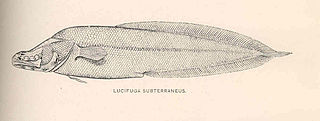Ophidiiformes is an order of ray-finned fish that includes the cusk-eels, pearlfishes, viviparous brotulas, and others. Members of this order have small heads and long slender bodies. They have either smooth scales or no scales, a long dorsal fin and an anal fin that typically runs into the caudal fin. They mostly come from the tropics and subtropics, and live in both freshwater and marine habitats, including abyssal depths. They have adopted a range of feeding methods and lifestyles, including parasitism. The majority are egg-laying, but some are viviparous.

The cusk-eel family, Ophidiidae, is a group of marine boney fishes in the order Ophidiiformes. The scientific name is from the Greek ophis meaning "snake", and refers to their eel-like appearance. True eels, however, diverged from other ray-finned fish during the Jurassic, while cusk-eels are part of the Percomorpha clade, along with tuna, perch, seahorses, and others. Unlike true eels of the order Anguilliformes, cusk-eels have ventral fins that are developed into a forked barbel-like organ below the mouth. In the true eels by contrast, the ventral fins are never well-developed and usually missing entirely.

Lucifuga is a genus of viviparous brotulas. Most of the species are native to caves and sinkholes in Cuba and the Bahamas; L. inopinata from deep water off the Galápagos Islands is the only exception. The four species rated by the IUCN are all considered vulnerable. The largest species in the genus reaches about 15 cm (5.9 in) in length.
The New Providence cusk-eel, Lucifuga spelaeotes, is a species of cavefish in the family Bythitidae. It is endemic to the Bahamas, where it has been reported from a small number of marine blue holes, inland caverns and chasms. It is the only known cusk eel species that can occur in surface waters; all others exclusively live in the deep parts of the ocean, or in underwater caves. It was first described in 1970.

Saccogaster is a genus of viviparous brotulas. They are found in the western Atlantic and Indo-Pacific.
Bellottia is a genus of viviparous brotulas which is found in the subtropical waters of the North Atlantic, the Mediterranean Sea and the Indo-Pacific.
Eurypleuron is a genus of pearlfishes, with these currently recognized species:
Enchelybrotula is a genus of deep-water cusk-eels.
Lamprogrammus is a genus of cusk-eels.

Lepophidium is a genus of cusk-eels.
Luciobrotula is a genus of cusk-eels.

Ophidion is a genus of cusk-eels.

Otophidium is a genus of cusk-eels, part of the subfamily Ophidiinae in the family Ophidiidae. They are found in the western Atlantic and eastern Pacific.
Parophidion is a genus of cusk-eels found in the Atlantic Ocean and the Mediterranean Sea.

Pycnocraspedum is a genus of cusk-eels.

Sirembo is a genus of cusk-eels of the subfamily Neobythitinae, family Ophidiidae, which are found in the Indian and Pacific Oceans. The species in this genus have a rather robust body with the dorsal fin originating over vertebrae 1–5. The head and bod are completely covered in scales, they have large eyes which are almost equal in diameter to the length of snout, the pelvic fins have two rays which are joined together within an area of tough skin, They have a short spine on the operculum which does not extend to the posterior edge of the head. Their coloration is variable but almost all species have black spots or eyespots on the dorsal fin, sometimes both, while the middle part of the anal fin frequently has a black band. The body and/or head are marked with diagonal or horizontal dark stripes or horizontal rows of quite large dusky spots.
The faceless cusk is a species of cusk-eel found in the Indian and Pacific Oceans at depths from 3,935 to 5,100 m. This species grows to 28.5 cm (11.2 in) in standard length, and is the only known member of its genus.
The gargoyle cusk is a species of cusk-eel from the subfamily Neobythitinae of the family Ophidiidae. This species grows to a length of 57 centimetres (22 in) TL. It is the only known member of its genus. The specific name honours George S. Myers (1905-1985) of Stanford University who taught the describer, Daniel Cohen, ichthyology. It is a rare benthopelagic fish which occurs at depths of 984–2,500 metres (3,228–8,202 ft) around the world, other than the eastern Pacific, in tropical and subtropical latitudes.
Brotulotaenia brevicauda is a benthopelagic marine fish species in the family Ophidiidae. This totally black fish is usually found in the Atlantic Ocean but it has also been reported in the Indian. B. brevicauda lives in deep water and grows up to 32 cm in length. It is also occasionally known as the Short-tail cusk-eel.

Bythitinae is a subfamily of viviparous brotulas, one of the two subfamilies in the family Bythitidae. This subfamily is characterised by having the dorsal, caudal and anal fins combined. They are mostly found in temperate to tropical seas, from reefs to the benthopelagic zone, but some species from the North Atlantic Ocean occur in into Arctic waters.







